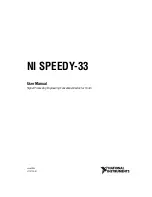
25
sound you should target mo
st adjustments to the Limiter sections, and avoid heavy use of the Final Limiter and fast
settings in the AGC sections. Using very fast attack and release times in the multi-band limiters - without pushing
them beyond 5dB or so of gain reduction - keeps IM distortion to a minimum
and
generates higher RMS levels. This
translates into higher perceived loudness.
On the other hand, using larger amounts of drive
to the multi-band limiters, along with faster release times will
generate far more consistency and d
ensity. Increases in final limiting depth (more drive) will further add to this. The
end effect is that the audio is now consistently loud - at all times.
The drawback to this kind of sound is that when taken to extremes, the excessive
density
can cause listener fatigue
and add additional coding artifacts. While Omnia ONE Multicast is designed to minimize listener fatigue, when
adjusted to do so it is capable of generating large amounts of density that could eventually lead to listener fatigue.
Adding Mo
re Detail
—When Loudness Isn’t the Last Word
Now that we’ve “squished the grape,” lets look at what it takes to undo a signal that is being too heavily processed.
Basically, we’ll just be reversing the procedures listed above and in this order:
1.
Reduce the
Drive
to the Final Limiter.
2.
Back off on the influence of the Limiter stages:
• Reduce the amount of
Drive
.
• Lower the
Release
settings in each band to slow down recovery.
• Raise the threshold of the
Hold
function.
3.
Ease up on the Wideband-AGC sections:
• Reduce the
Drive
to the Wideband-AGC.
• Lower the
Release
setting to cause it to operate slower.
Backing off the limiting sections first will allow the processing to still retain a level of loudness while restoring
punch and quality. Start with reducing the
Final Limiter
amount in 0.5 dB steps. It’s surprising how much detail can
be restored from such a small change. Generally, a change in the
Final Limiter
drive will have the most noticeable
effect on quality, but it will also affect the
relative loudness level, too. You’ll need to find a “happy medium” that’s
right for your application.
Equalization (EQ) Changes
Tailoring the shape of the overall audio spectrum can be done in four different ways:
Adjusting the
Drive
to the individual bands from within the
XOver
menu, which sets the input
levels to the multi-band AGC sections.
Changing the relative amount of
Drive
to the individual multi-band limiters.
Adjusting one or more bands to have faster release times than the others.
Adjusting the settings within the
Mixer
.
All four options will provide a noticeable change in EQ and each will have a different character. We suggest you use
the first two listed options before trying others. In each case the EQ change you make is followed by a
dynamically
controlled stage, so the subsequent AGC or Limiter will counter any excessive EQ adjustments.
The last option, adjusting the
Mixer
, is designed to provide a final
minor
trim to the audio spectrum. Since this stage
is
after
all of the dynamic multi-
band AGC and Peak Limiting, a radical change in level in the
Mixer
could result in
















































